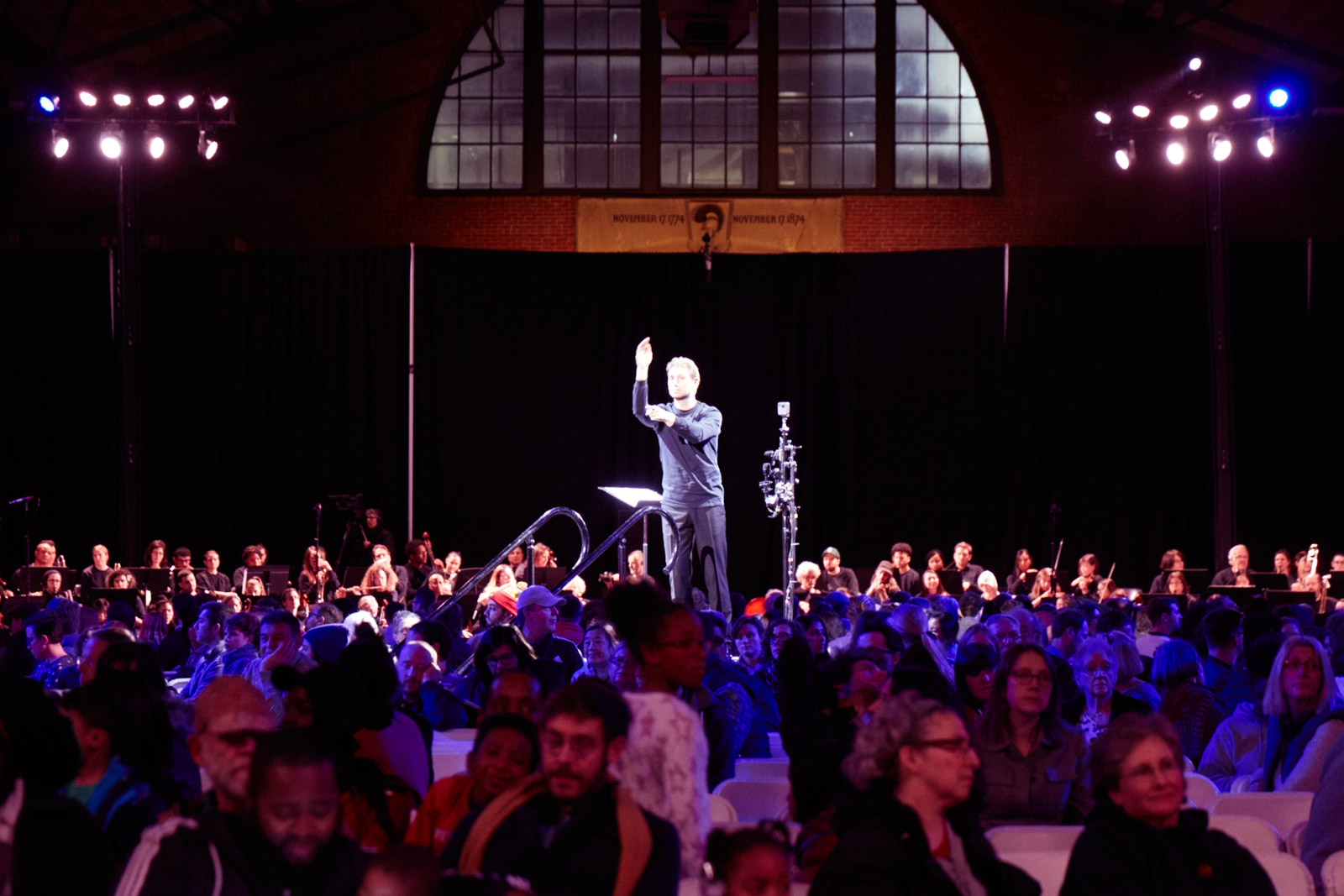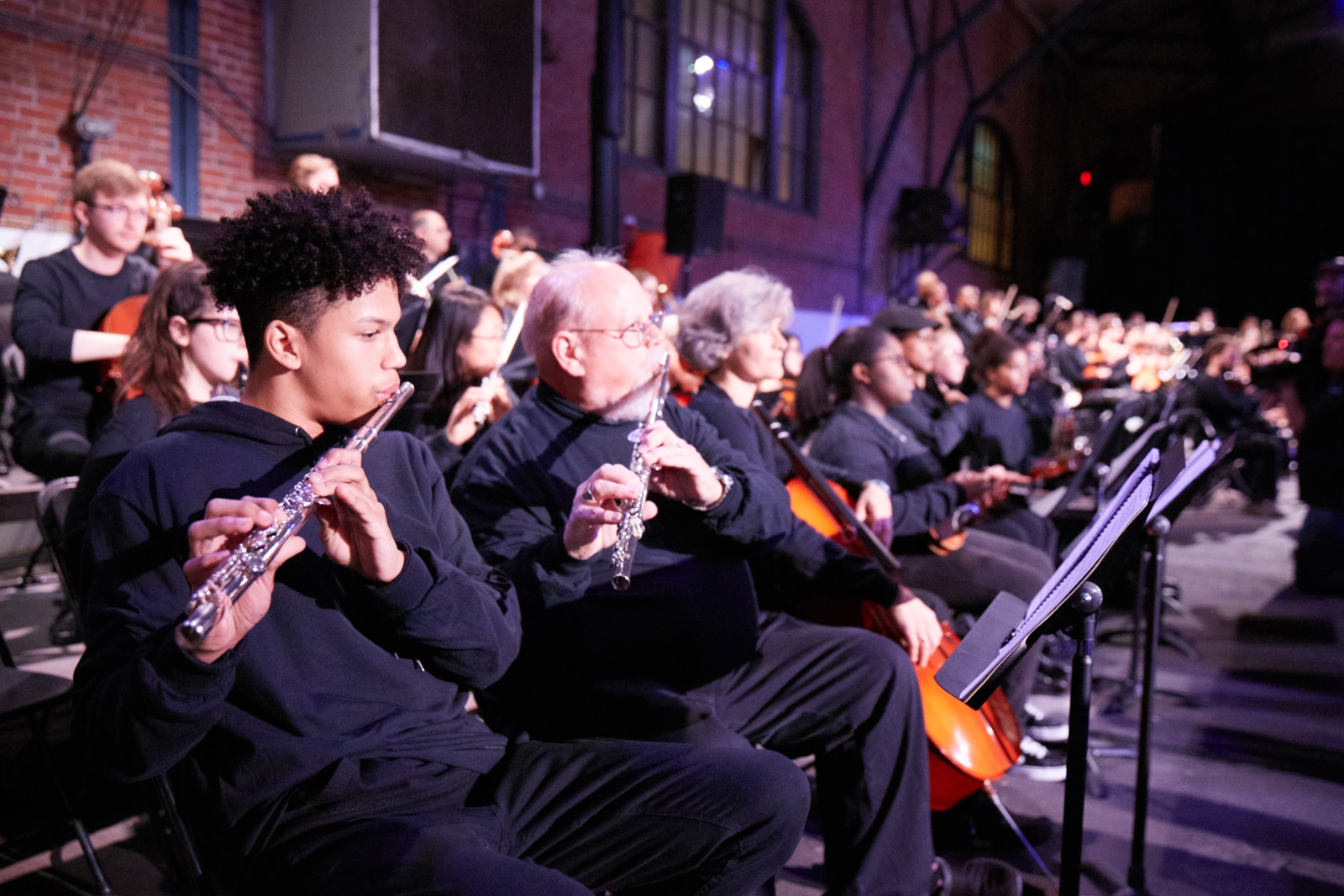Temple Contemporary + David Lang’s “Symphony for a Broken Orchestra”
A performance on damaged instruments to benefit public schools, from the acclaimed composer

In the first week of December at the 23rd Street Armory in Philadelphia, 400 or so instruments recovered from some 1000+ in a musical graveyard united in the hands of hundreds of professionals and students to perform a work by Pulitzer Prize-winning composer David Lang. Known as the “Symphony for a Broken Orchestra“—there will never be a performance like those two ever again. The epic piece and its world premiere, however, were only a part of the masterplan envisioned by Robert Blackson, director of Temple Contemporary at Temple University’s Tyler School of Art. In fact, these performances may have been a sonic gift to those in attendance, but the longstanding impact of the charitable events will help Philly youth retain musical education. Over $247,000 was raised (double the goal) through the effort, and it will go to repair those broken items and put them right back into the hands of students.
In 2013, 23 schools across Philadelphia—primarily in communities of color or areas with under enrollment and decentivization—shut their doors. The school district shuffled everything from library chairs and tables to musical instruments in one school in South Philly. Blackson toured the school and stumbled into a gymnasium filled with broken pianos, violins and more. Many of them had been hidden away for years as the region’s music budget was slashed from $1.3 million in 2007 to $50,000 in 2017. Blackson approached the district about an inventory—and access. Over 1000 instruments were documented and he was granted permission to do with them as he wished. “It came into my head that we could do something that might be beautiful and might show this huge challenge facing public schools,” he explains to CH. “I wanted to make something that raised awareness for all the city.”

Familiar with the work of Lang, Blackson initiated cold outreach—and the acclaimed composer, a public school alum, immediately jumped at the opportunity. The process began with a catalog of each instrument and its musicality. “Classical instruments are built to be the same,” Lang explains to us. “They’re supposed to blend together and not stand out in any way. When you play a violin and add a bunch more violins they all do the things violins do, together.” Naturally, broken instruments do not abide by this. “All of a sudden they can’t be generic representations of what they are supposed to do. You can look at them as being terminally damaged from being what they were built for. Each instrument was truly unique.”

“It was important that we took a look at what each of these was now capable of. I wanted to know what their uniqueness actually made possible,” he continues. “We have, at Bang on a Can, a social action wing which is an organization called Found Sound Nation that goes around the world doing musical good deeds. They cataloged every instrument and sampled each one to build an unbelievable database of these supposedly broken instruments. We never wanted to think that these instruments had been destroyed. We thought of this as being a great opportunity to see how they are still capable of music-making, only as a different type of instrument.”

Lang says the database was very useful for tone colors and what problems certain instruments were facing. “I can’t say that I actually used it when composing,” he clarifies. “By listening to them all, it gave me a way to imagine what the note would be or what a chord would sound like or what an action that a normal instrument would go by what this action would sound like on a group of these.” It helped him to imagine the sound world he would be existing in, but Lang took it from there.
He paid careful attention to those who would take up each instrument, as well. “A lot of my decisions about things to do in the piece came from a sense that would showcase the community of people who would play.” There was the widest spectrum here, from professionals to young children who barely knew how to make a sound on an unbroken instrument. “I wanted to make a musical event that would showcase this moment when the community came together to play them, to show these problems.

As for the performances, “I was really moved by the whole thing,” Lang says. He structured the music so that the performers themselves learn what their instrument can do along the way, beginning with percussion and progressing through notes and chords. “Eventually,” he says, “everyone has to learn how to play a melody together. It turned out to be very emotional for everyone. The performers came together. They donated their time. The audience came together. It was very clear that this was a community event. We all knew that fixing these instruments would benefit the larger community. It was not about making one instrument better but elevating the citizens of a city.”
Continuing to describe its beauty, Blackson explains that “For me, having been quite a novice to orchestral performances, I noticed that the piece changed so much from one performance to the next—from dress to the first to the 730 performance later that evening. Power and beauty came from the way that each was differently interpreted by the musicians. It was a requirement for them to listen to one another and shift based on the emotions they were feeling at each performance. The common denominator was that it doesn’t matter what age or skill set you have but that we need to listen to one another and by understanding this we can make something beautiful.”

Lang cannot express his gratitude enough for his own public school education. “Classic music was not part of my home life,” he notes. “It wasn’t supposed to be part of my life, at all. I became exposed to music by accident in the public schools. I got very little musical support throughout my life. The support I got for thinking that music should be part of my imagination all came from public schools. I was educated completely in public schools. It is only because there was music in my schools that I became a musician. It is deeper. I learned to be a citizen. I first confronted ideas that needed to be worked on by more than one person. I learned how to get along with other people.”

He continues that “I got an emotional power out of an abstract thought. All these things that ended up being really important to me came from music. My first response [when Blackson called] was not ‘I can do something beautiful with the music’ it was that ‘I am only a musician because there was music in the schools.'” Lang says that if there were 1500 missing instruments at school, that could very well mean there are 1500 kids who are missing out on a future in music. “We are all going to be called upon to do our duty to do extra things to fix that which needs fixing,” he concludes.

There is an eco-system to instruments, he made clear: they are created, played, broken, fixed and returned. With this program, Blackson and Lang are trying to facilitate the last few steps—and teach teachers how to fix small breaks to instruments.
“When I look at the list again in 2020, I hope that it is a very small list that needs repairing,” Blackson says. “My ultimate hope is that these instruments will continue to be repaired, in perpetuity, thanks to the generosity of others who believe children need musical education.” We’d have to agree with him on this one.
You can still adopt an instrument for repair online.
Images by Karl Seifert, Courtesy of Symphony for a Broken Orchestra












